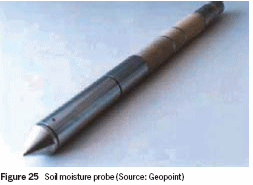Chapter 4
Part 1: Special cones: geotechnical cones
Soil moisture probe (SMP)
| SOIL MOISTURE PROBE (SMP) 4.7 | ||
| Composition The soil moisture probe (SMP) is installed directly behind the electric cone and permits the simultaneous acquisition of resistivity, soil moisture and geotechnical data (Figure 25). The probe comprises two ring-shaped and carefully isolated electrodes, and an application-specific integrated circuit (ASIC). The ASIC uses synchronous detection for accurate measurements free from electric interference. Soil moisture Dielectric soil properties, capacitance and electrical conductivity are governed mainly by the water content of the soil mass. By measuring these parameters between two electrodes, with the soil dielectric in between, the soil moisture can be determined. |  | |
| The capacitance of dry soil is determined by its dielectric constant. For dry soil this constant is of the order of 3 to 6 and for water the constant is 80; in other words, the capacitance between the two electrodes is dominated by the volume fraction of water. Contaminated soils In polluted soils, non-aqueous phase liquids (NAPLs, eg oil or chlorinated solvents) will replace part of the water in the soil matrix. As they do not dissolve easily in groundwater, they will occur as a film of pure product, often just above the groundwater table. Dense NAPLs such as chlorinated hydrocarbons, which are denser than water, will penetrate the groundwater table and are typically found on top of impermeable layers. These pollutants affect the dielectric properties of the soil significantly and are detectable using the soil moisture probe. Test results are shown in Figure 26 below. |
